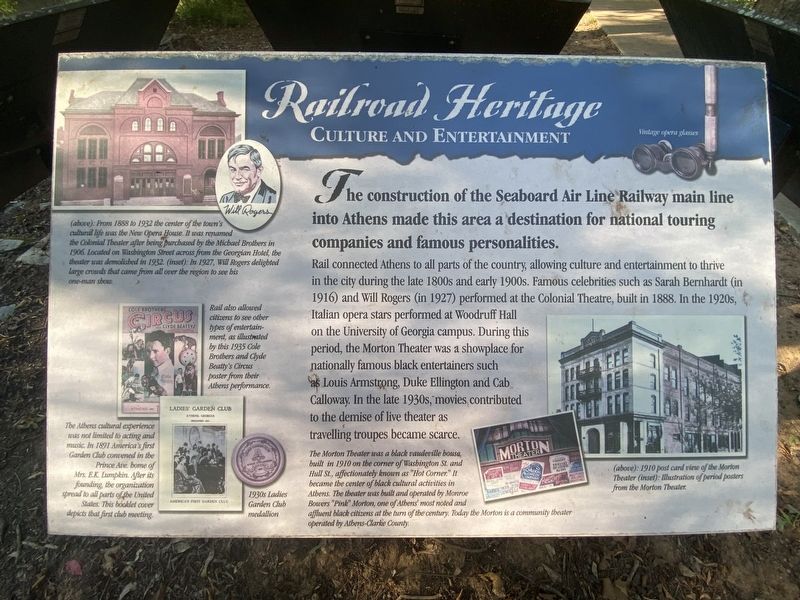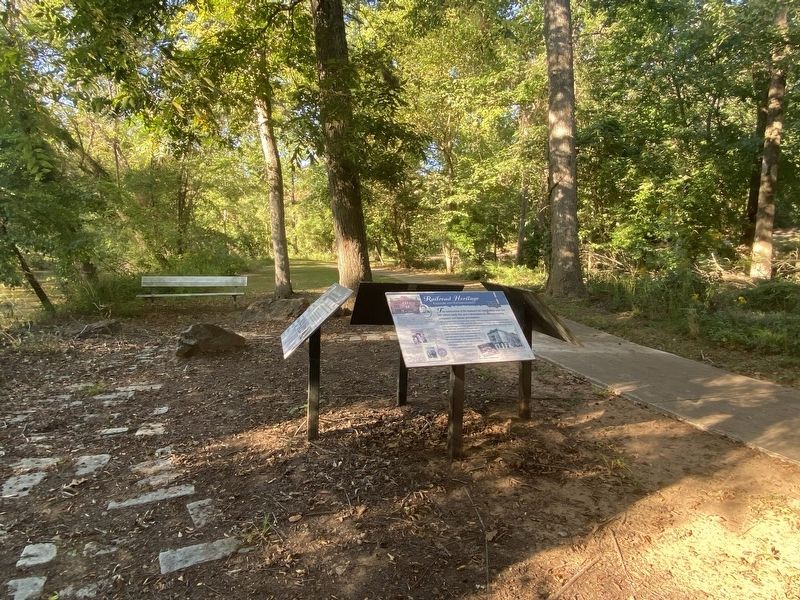Athens in Athens-Clarke County, Georgia — The American South (South Atlantic)
Railroad Heritage
Culture and Entertainment
The construction of the Seaboard Air Line Railway main line into Athens made this area a destination for national touring companies and famous personalities.
Rail connected Athens to all parts of the country, allowing culture and entertainment to thrive in the city during the late 1800s and early 1900s. Famous celebrities such as Sarah Bernhardt (in 1916) and Will Rogers (in 1927) performed at the Colonial Theatre, built in 1888. In the 1920s, Italian opera stars performed at Woodruff Hall on the University of Georgia campus. During this period, the Morton Theater was a showplace for nationally famous black entertainers such as Louis Armstrong, Duke Ellington and Cab Calloway. In the late 1930s, movies, contributed to the demise of live theater as traveling troupes became scarce.
(captions)
(above): From 1888 to 1932 the center of the town's cultural life was the New Opera House. It was renamed the Colonial Theater after being purchased by Michael Brothers in 1906. Located on Washington Street across from the Georgian Hotel, the theater was demolished in 1932. (inset): In 1927, Will Rodgers delighted large crowds that came from all over the region to see his one-man show.
Rail also allowed citizens to see other types of entertainment, as illustrated by this 1935 Cole Brothers and Clyde Beatty's Circus poster from their Athens performance.
The Athens cultural experience was not limited to acting and music. In 1891 America's first Garden Club convened in the Prince Ave. home of Mrs. E.K. pumpkin. After its founding, the organization spread to all parts of the United States. This booklet cover depicts that first club meeting.
The Morton Theater was a black vaudeville house built in 1910 on the corner of Washington St. and Hull St., affectionately known as "Hot Corner." It became the center of black cultural activities in Athens. The theater was built and operated by Monroe Bowers "Pink" Morton, one of Athens' most noted and affluent black citizens at the turn of the century. Today the Morton is a community theater operated by Athens-Clarke County.
(above): 1910 post card view of the Morton Theater (inset): Illustration of period posters from the Morton Theater).
Topics. This historical marker is listed in these topic lists: African Americans • Arts, Letters, Music • Entertainment • Railroads & Streetcars. A significant historical year for this entry is 1888.
Location. 33° 57.335′ N, 83° 22.057′ W. Marker is in Athens, Georgia, in Athens-Clarke County. Marker can be reached from Oconee Street (Business U.S. 78) 0.4 miles west of South Poplar Street, on the right when traveling west. Touch for map. Marker is at or near this postal address: 393 Oconee St, Athens GA 30601, United States of America. Touch for directions.
Other nearby markers. At least 8 other markers are within walking distance of this marker. A different marker also named Railroad Heritage (here, next to this marker); a different marker also named Railroad Heritage (here, next to this marker); a different marker also named Railroad Heritage (here, next to this marker); A City Gets on Track (within shouting distance of this marker); a different marker also named A City Gets on Track (within shouting distance of this marker); Dudley Park (within shouting distance of this marker); a different marker also named Dudley Park (within shouting distance of this marker); Oconee River (about 300 feet away, measured in a direct line). Touch for a list and map of all markers in Athens.
Credits. This page was last revised on October 12, 2022. It was originally submitted on October 11, 2022, by Darren Jefferson Clay of Duluth, Georgia. This page has been viewed 74 times since then and 13 times this year. Photos: 1, 2. submitted on October 11, 2022, by Darren Jefferson Clay of Duluth, Georgia. • Devry Becker Jones was the editor who published this page.

